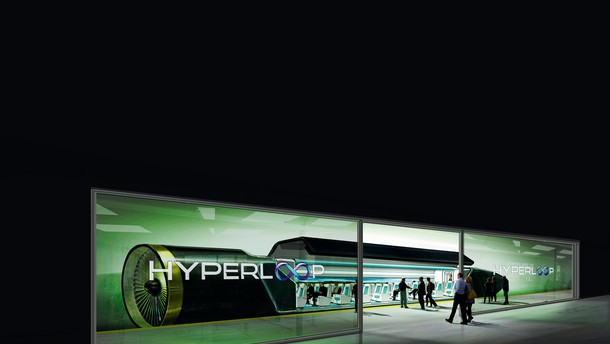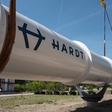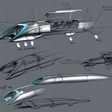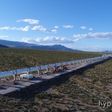
While he's busy trying to revolutionize space travel, automobiles and the power industry, other companies accepted the challenge to make a dream into reality. Thus far, Hyperloop One and Hyperloop Transportation Technologies (HTT) start-ups have made the most advances.
Civilization is fully reliant on transport that is, in this day and age, much too ravenous, in terms of energy. Rail and road transport use most of it on overcoming friction and air resistance. But such a waste of energy may be mitigated, or even erased, by the Hyperloop system, a reduced-pressure tube in which capsules ride on a pressurized air cushion, driven by a fan and electromagnets in the tube's walls. Floating on an air cushion, capsules are up against little to no friction, while low pressure or perhaps even a vacuum would eliminate air resistance altogether. As such, the capsules could travel nearly as fast as sound, while using very little energy. Musk also contrived solar cells that would run along the tubes, providing power to the system from renewable sources.

Flirting with the old ideas
To better understand why the Hyperloop system has been highly praised, even though much of it is still unknown, we should recall the ideas that spurred Musk into creative thinking. To do that, we must leap back into the age of steam locomotives, and the concept of an atmospheric railway, wherein the power for propulsion is provided by differential air pressure in front of and behind a train. But that can only work in a tunnel. In 1864, south London received an experimental 500 meter-plus railway line called Crystal Palace, where a carriage was propelled by a large fan powered by a steam engine. The rail was only open for about a year, but that didn't deter others from attempting similar feats.
In the beginning of World War I, a Russian professor, Boris Weinberg, thought of a vacuum train, the so-called "vactrain," which played an important role later, when the idea of a tunnel connecting North America and Europe emerged. And what a crazy idea it was, as crazy as the speeds they contemplated—between 6000 and 8000 kilometers per hour. In any case, "vactrain" is a theoretical tube-based transport system that works by way of magnetic levitation. Next to unthinkable production costs, such a system will also confront a question of how to secure a vacuum throughout the tube.

Magnetic levitation is likewise used to propel the Maglev trains, which are no longer just a theory. Aside from a few test lines, the Chinese built the fastest Maglev commercial railway line that runs between the city of Shanghai and its international airport, and another one was built in Japan. Like many others, had the Germans had enough resources at their disposal, they would have laid one down in the capital of Bavaria. The Maglev train propulsion takes advantage of electromagnets that keep the train slightly off the rail, eliminating friction and allowing movement. The Chinese train utilizes no tubes, and is therefore forced to fight air resistance. Nevertheless, it can travel at a speed of 430 km/h. Such systems are no longer in demand, because they cost too much, and can rarely be afforded. To elaborate on that, from the investors' point of view—it will be a long while before the initial investment will be paid back.
Levitation, induction motors, fans and more
Musk's original design anticipates the automated aerodynamic capsules carrying passengers or cargo to move through semi-vacuum or low-pressure tubes. The capsules levitate on an air cushion ranging from 0.5 to 1.3 mm in thickness, similar to a puck used in air hockey, thanks to the properly shaped air cushion "skis." No energy is expended on magentic levitation, not even at the expense of speed—by losing friction, a capsule will travel at 1220 km/h, which is more than the speed sustained by the wheels. The linear induction motors along the tube walls will accelerate, as well as decelerate, the capsule to the desired speed. To avoid the increase in air resistance, or even stopping of the capsule, the air that has been caught under the capsule during the ride must be transferred by the fan in the nose of the vehicle to the back, and partially underneath the "skis." This painfully simple and, at first glance, feasible idea spurred Elon Musk and his Space X company to announce the construction of a nearly two kilometer-long test track, next to the company site.
Beyond being successful in attracting investors, it's a risky business, and the seconds-long test that was carried out by the Hyperloop One company, the Hyperloop One and the HTT technology are still a mystery. While the first company seems to swear by Musk's concept, the second may pull away, in favor of a passive magnetic levitation technology that was invented by the late American scientist, Richard F. Post. Within such a system, the induction motors would not be spread across the tube at every 60 kilometers or so, but they would be found on the trains, which would levitate with the help of strong permanent magnets built into it. This option is more cost-effective, because it requires no propulsion infrastructure to be built into the tunnels—the reason why Maglev trains cost so much. It is also safer since even in the face of a power failure, the magnets ensure levitation until the train has slowed down enough to be able to gently touch the ground.
Premature promises of success
While Hyperloop system has been subject to many speculations and promises about the very first commercial train, be it in Slovakia, Switzerland or Russia (where the project would be funded by one of their oligarchs), in reality much of it is still shrouded in mystery. It will compete with domestic air transport that doesn't require costly infrastructure, for instance. But, as pointed out by the Hyperloop system advocates, to reach a cruising altitude of ten kilometers, aircrafts use up huge amounts of energy, none of which is ever restored during the descent. Moreover, because air pressure in the tunnel is equal to the air pressure at an altitude of fifty kilometers, ovecoming air resistance in the tunnel is less of a struggle than in the air. Hyperloop system thus seems to be more economical than air transport, and poses less a threat to the environment by using energy from renewable sources, than fossil fuels.

So the only legitimate complaint would be the initial expense of the infrastructure, which surpasses that of a high-speed train, and certainly the costs related to internet networks, which some like to compare to the Hyperloop system. On the other hand, economists admit to the concept being a good one, especially with regard to cargo transport. Railways are profitable and efficient today, and a rapid connection between major urban centers could thus have an economic rationale. Yet, the economics of the project are still hard to estimate. Every major transport project must strike a balance between three factors: construction, functionality and profitability. The first two are less difficult than the third, which is also why such projects are realized with taxes.
The Hyperloop system is only at the start of its journey, and we should expect a long wait before anyone starts building tubes for them. There are still so many problems to solve, such as how to sustain low air pressure tubes that are a few hundred kilometers long, as efficiently and frugally as possible. Questions of safety and the environmental impact must also be answered. For this reason, we can say that, to make this happen, you either have to go all in or not at all.



